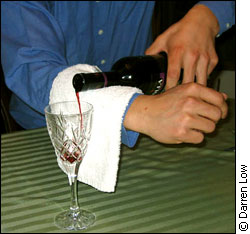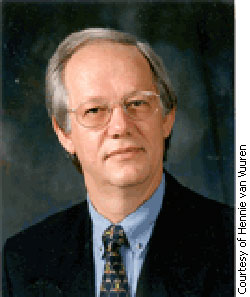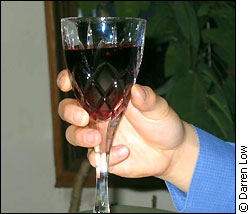
|
He talks as if there’s a conspiracy surrounding the wine industry. “Nobody in Canada and the United States even suspects that their wine is genetically modified,” says the retired professor of genetics. And for a conspiracy theory, it does seem to have all the right elements: government cover-ups, hush-hush industry big wigs, brilliant scientists and an oblivious public — except for the occasional skeptic. Pssst, it’s even Canadian. But if wine made with genetically modified yeast is supposed to be a big cover-up, the plotters haven’t done a very good job because the information is out there and easily accessible. People just don’t know it. The truth is, Dr. Hennie van Vuuren at the Wine Research Institute in British Columbia has created a genetically modified wine yeast that would cause some red wine lovers to sing “Hallelujah” while popping open multiple bottles of wine, and others, like Cummins, to sorrowfully brood over yet another favourite food gone awry. The altered strain, called the ML01 malolactic yeast, has already gotten the thumbs-up from the United States’ Food and Drug Administration — and that was two years ago. With the FDA seal of approval known as Generally Regarded As Safe status, the altered strain can be used in commercial wine production, at least in the United States. However, few people have heard of it, and even fewer know how the yeast strain works and exactly what it does. And those who do know a bit about wine might still need a little convincing.
Michael Bartier, a winemaker at Golden Mile Cellars in British Columbia says, “Wine is one of the few or last bastions of wholesome gracious living of natural food sources. And it is — I consider it very much a health food.” If red wine is a health food, then it just got healthier for about one-third of red wine drinkers with the help of some gene-tinkering by van Vuuren. A taste of winemakers’ trouble Normally, in the production of red wine, the wine passes through two different fermentations. The first is the standard alcoholic fermentation where sugar is converted into alcohol and carbon dioxide using a yeast strain to catalyze the reactions. After this first fermentation though, red wines go through a second fermentation, the malolactic fermentation, using bacteria to convert malic acid into lactic acid. Lactic acid is softer on the palate, and as Bartier explains, “That’s certainly the idea with red wine. The softer the better.” While this second fermentation is essential for the production of most red wines and some white wines, like Chardonnay, it comes with a lot of baggage. At this stage, the yeast cells from the alcoholic fermentation have used up the nutrients present in the grapes, there’s a high alcohol level present and the pH is low. It’s a tough battle for survival in this kind of environment for the malolactic bacteria. Stunted in growth, some malolactic bacteria just can’t make it. Winemakers end up with wine that sits in cellar barrels, waiting days, weeks and months for a malolactic fermentation that sometimes is never completed. During this waiting period though, it’s possible for other bacteria to grow — other less desirable bacteria. These unwanted bacteria, and also some malolactic bacterial strains, convert naturally occurring amino acids in the wine into bioamines. Bioamines are compounds that cause some wine drinkers to have negative reactions to red wine because they don’t have the enzymes needed to break down the compounds. A familiar example of a bioamine is histamine, which is a protein that causes many allergic reactions.
Some of the reactions include severe migraines, asthma attacks and skin rashes. van Vuuren says, “Many people don’t drink red wine because of this problem.” For the past 13 years, he’s tackled the problem of how to make red wine enjoyable for everyone, including himself. “I’m one of those unfortunate people who get headaches when I drink wine that contains these bioamines and I love wine,” he says. “So that’s one of the reasons why I started to work on it.” A toast to health To create the ML01 malolactic yeast, van Vuuren took the gene that catalyzes the conversion of malic acid to lactic acid from the malolactic bacterium Oenococcus oeni and added it to the common wine yeast strain, Saccharomyces cerevisae. He also added the malic acid transport gene from the yeast Schizosaccharomyces pombe so that the malic acid can enter the wine yeast cells in the first place. These slight genetic additions to the yeast means that the altered yeast can perform both fermentations at the same time, without the need for a separate malolactic bacteria. Since only one fermentation is needed, there is no time for unwanted bacteria to grow and produce the offending bioamines. In other words, no more headaches for red wine lovers. “Strictly from a processing point of view, [the altered yeast] is brilliant,” says Bartier, who has attended some of van Vuuren’s lectures on genetically modified wine yeasts. “I mean, that would really make things go a lot easier in a winery.” However, van Vuuren says he didn’t create his yeast for the producers — it’s supposed to be made with consumers in mind. After all, he’s not working for just one big corporation — his funding comes from various sources, including the federal government, Vancouver companies, the B.C. wine industry and international yeast companies. How good is it, really? To put consumers’ minds at ease about how wine made with the altered yeast would taste, sensory taste tests have been done and the wine has been broken down into its components and analyzed. Van Vuuren says the wine tastes “exactly the same as the other wines.”
Bartier is less optimistic about how the wine would taste. “Different yeast strains react differently in wine and they will … release different compounds where they’ll certainly affect the dynamic of the fermentation, which is going to affect your flavours,” he says. “I have no idea if it’ll be good or bad.” More importantly though, there are some who are completely against the idea of genetically modified anything because they think it’s just plain dangerous. Joe Cummins, who is now an emeritus professor at the University of Western Ontario, says he is worried about unexpected toxic products from genetic alterations and says van Vuuren should be doing more to prove that the wine is safe to drink. “I really am very distressed that the people in commercial biotechnology tend not to be very … responsive to criticisms and facts,” Cummins says. “They tend to overlook these things and not be serious about testing.” But van Vuuren says Canadians have been eating genetically engineered foods for years without any problems. He says that his wine yeast doesn’t contain any genes that wouldn’t have been there in normal winemaking and that any yeast cells remaining after the fermentation would be filtered out before the wine is bottled. So he doesn’t have any problem drinking wine made with his yeast. “I know what my choice would be if I get headaches and I could have a wine that doesn’t give me headaches,” he says. Testing the water It’s a decision that Canadians might be making soon. Van Vuuren applied 18 months ago to Health Canada and Environment Canada to gain permission to use the yeast in Canadian commercial wine production. He says he expects a positive reply early this year.
When the government makes its decision, producers and consumers will also have to form their own opinions and their choices just might give van Vuuren a different kind of headache, one that science can’t fix. Bartier says that although the yeast would make his life in the cellar a little easier, he can’t ignore consumer reaction. “I would not want my wine to be tainted, whether fair or unfair, as a Frankenfood,” he says. “I wouldn’t even contemplate using it. I just don’t want my winery anywhere near such a controversy.” It’s questionable though whether there would even be a controversy because not many people seem to be aware that wine made with genetically modified yeast exists. Jeff McDonald, the British Columbia Wine Institute spokesperson, says the organization has good contact with wineries in the province, but no one has ever brought up concerns about the new yeast. “I’ve never heard of genetically modified [yeast],” he says. “This is the first I’ve heard of it.”
While Canadians even in the wine industry might not know a lot about wine made with genetically modified yeast, Cummins thinks that the altered wine is already available in Canada, compliments of the United States. He refuses to buy any American wine because the FDA doesn’t require labeling of genetically modified food. “They avoid [labeling], you see, because it stigmatizes the wine,” he says. “It’s quite a top secret operation in order to avoid having these wines stigmatized.” And while a conspiracy theory about labeling might or might not be valid, as far as conspiracy theories go, this next one just might affect your regular Canadian: Wine made with genetically modified yeast is coming to a store near you. In fact, it may already be there.
|
|
|


